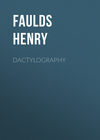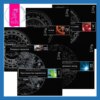Читать книгу: «Dactylography», страница 7
GLOSSARY
OF SOME TERMS USED BY DACTYLOGRAPHERS
Accidentals. Nondescript patterns in the class composites.
Anthropoid. Of the great man-like apes (gorilla, orangutan, and chimpanzee).
Anthropometric. Bodily measurements.
Anthropometry. Science of accurate bodily measurements.
Arch. A curved set of lineations, without backward turn; a bow.
Bertillonage. Alphonse Bertillon’s anthropometric methods.
Bifurcation. Fork-like splitting into two branches.
Blur. A dull, smudgy imprint.
Bow. A curved lineation like a bow.
Bulb. The pad of a finger-tip.
Characteristic. Any striking feature in a pattern which gives distinctiveness.
Chirality. The principle involved in “Mirror Patterns.”
Composite. Patterns composed of various elements, such as arch, loop, or whorl.
Core. The heart or central portion of a finger-print.
Crease (palmar). The lines which indicate folding of the hand surface.
Dactylograph. A finger-impression taken by any process.
Dactylolite. An indented finger-print as on wax.
Dactyloscopy (Daktyloskopie). The practical study of Finger-prints.
Delta. A somewhat triangular figure formed by skin lineations.
Derma, Dermal. The deep true skin, the “quick.”
Digit, Digital. A finger, of fingers.
Epidermis. The upper skin which readily peels off.
Epithelium. The scaly surface of skin.
Exhibit. An article to be shown in court as evidence.
“Flexible Curves.” An instrument for measuring enlarged curving lineations.
Fork. A Y-like figure.
Formula (pl. Formulæ). The arrangement of syllables or signs to denote a set of finger-prints.
Furrow. The hollow line between ridges, a sulcus.
Hook. A J-like figure in any position.
Index Finger. The finger used in pointing.
Junction. Where two lineations meet or break off.
Lineation. A line as printed, whether ridge or furrow.
Loop. A curved line which returns on itself.
Micrometer. An instrument like a pair of compasses, used for fine measurements.
Mirror Pattern. The reverse (exact) image of a given figure.
Negative. A print in which the ridges are white and furrows black, as when smoked glass is used.
Palmar. Of front surface of the hand.
Papilla (pl. Papillæ). Elements in a ridge where touch organs are.
“Photograph.” Used sometimes legally for finger-prints.
Pocket Loop. A variety of imperfect loop.
Positive. A finger-print where ridges appear black (or other colour of pigment used) and furrows are white.
Primates. An order of animals, including lemurs, monkeys, apes, and man.
Radial. The thumb side of the hand (opposed to Ulnar.)
Recognition. An identification.
Recidivist. A relapsing or incorrigible criminal.
Ridge. A line of skin tissue, elevated, with sweat-pores.
Rod. A figure like a rod.
Rolled Print. A finger-print not taken by direct or plain impress, but by a revolution of the inked surface on flat paper.
Ruga (pl. Rugæ). A ridge.
Searcher. One who seeks for a former registration.
Sebaceous. Of the greasy excretion of the skin.
Smudge. A blurred or dull imprint.
Staple. A figure like a U inverted; thus,  .
.
Sudor. Sweat.
Sudoriparous. Of sweat, sweat-yielding.
Sulcus (pl. Sulci). A skin groove or furrow.
Twinned Loop. Two adjoining loops in a core, complementary in position.
Tented Arch. An arch shaped like a tent or volcanic mountain.
Terminus. A term used for distinctive points within and without a core.
Ulnar. The little finger side of the hand. (Opposed to Radial).
Verso. May be used for an imprint as the converse of the fleshy pattern.
Whorl. A flat spiral figure.
Widdershins. The reverse of a clock-hand’s movement.
SHORT BIBLIOGRAPHY
Asquith’s Committee. – [Blue Book.] “Identification of Habitual Criminals,” 1894.
Clemens, S. L. (Mark Twain.). – “Pudd’nhead Wilson” A story illustrating the principles of Finger-Print Identification.
Darwin, Charles. – “Origin of Species,” 1859; “Descent of Man,” 1871.
Devon, James. – “The Criminal and the Community,” 1912.
“Encyclopædia Britannica.” – “Finger Prints,” etc., 1911.
Faulds, Henry. – “On the Skin-furrows of the hands,” (Nature, chap. xxii., p. 605), 1880; “Dactyloscopy” (St. Thomas’s Hospital Gazette), January, 1904; “Guide to Finger-Print Identification,” 1905; “Finger Prints: a chapter in the History of their use for Personal Identification,” (Knowledge), April, 1911.
Ferrero, G. L. – “Criminal Man” (Lombroso’s), 1911.
Forgeot, René. – “Les empreintes latentes” (Thesis), 1891.
Galton, Francis. – “Identification by Finger-Tips” (The Nineteenth Century), August, 1891; “Finger Prints,” 1892; “Finger-Print Directories,” 1895.
Garson, J. G. – “Finger-Prints Classification” (Jour. Anthrop, Inst., chap. xxx. p. 101), 1900.
Glaister, J. – “Textbook of Medical Jurisprudence,” 1902 (and 2nd edition).
Gray, H. – “Anatomy, Descriptive and Surgical,” (16th ed.) 1905.
Haddon, A. C. – “Races of Man, and their Distribution,” 1909; “History of Anthropology,” 1910.
Henry, E. R. – “Classification and Uses of Finger-Prints,” 1905.
Hepburn, D. – “The Papillary ridges on monkeys’ hands and feet,” (Nature, vol. liii., 36), 1895.
Herschel, W. J. – “Skin Furrows of the Hand,” (Nature, vol. xxii., 76), 1880.
Hopf, Ludwig. “The Human Species,” (Eng. trans.) 1909.
Lindsay, B. – “Animal Life.”
Marett, R. – “Anthropology.”
Mitchell. “Science and the Criminal,” 1911.
Purkinje, J. E. “Commentatio de examine physiologico organi visus et systematis cutanei,” 1823.
Schlaginhaufen, Otto. “Der Hautleistensystem der Primatenplanta” (with a valuable bibliography), Gegenbaur’s Jahrbüch, 1905.
Schofield, A. T. “Elementary Physiology for Students,” 1892.
Stewart, G. N. “Manual of Physiology,” 1910.
Thomson, J. A., and P. Geddes. “Evolution,” 1911.
Tylor. “Primitive Culture,” 1903.
Walker, N. “Introduction to Dermatology,” 1904.
Wallace, A. R. “The World of Life,” 1910.
Windt and Kodiček. “Daktyloskopie,” 1904.
FOOTNOTES:
[A] In Professor Giles’s Chinese-English Dictionary (1909) on page 223 some characters are given for “to make a finger-print,” etc.
[B] See Nature (January 17th, 1895), “Finger-Print Method,” Kumagusa Minakata.
[C] Guide to Finger-Print Identification (p. 11).
[D] See Guide to Finger-Print Identification (fig. 12)
Покупайте книги и получайте бонусы в Литрес, Читай-городе и Буквоеде.
Участвовать в бонусной программе










